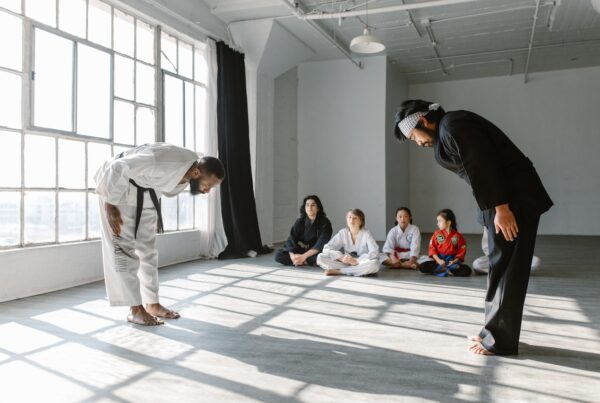Taekwondo could be effective in self defense because it includes many practical techniques in a real-world scenario – like dodging, blocking, and footwork which can help you evade attacks and defend yourself if you’re caught in a street fight.
Taekwondo is a popular martial art used for both self-defense and competition. But can it be used to defend yourself against an attacker?
I’ve had many people ask me whether they should learn taekwondo for self-defense. There’s a lot that goes into learning self-defense. Although learning taekwondo won’t make you a self-defense expert, it can be a valuable tool to have in your arsenal.
This article goes over whether taekwondo can be used for self-defense, how you can train, and a few tips for self-defense with taekwondo.
Table of Contents
Can Taekwondo Be Used for Self Defense?
Taekwondo can be an effective means of self-defense if used correctly and can be used to disarm an opponent by using the proper techniques and strikes. It focuses on kicks, punches, and guard techniques to defend against opponents.
Taekwondo is a physically and mentally challenging art form that can take years to develop the skills necessary to effectively defend oneself. However, with proper instruction and practice, taekwondo can effectively protect oneself from harm.
Taekwondo is a popular martial art that is used for self-defense. There are many different styles of taekwondo, each with its own benefits and techniques and it can effectively defend against attacks from both MMA fighters and street attackers. The principles behind taekwondo are similar to those behind other martial arts, such as judo and karate, which can help you defend yourself against a more experienced or stronger opponent.
Taekwondo is a physical martial art that was developed in Korea and can be effective in self-defense if the student can learn specific techniques and moves to protect them from MMA fighters or street attackers. However, it is essential to note that taekwondo is not a complete self-defense system, and students should also learn how to escape from dangerous situations.
That said, taekwondo is not a perfect form of self-defense. It is a practical martial art that can help protect the user from harm. Self-defense, especially in street fighting, is more dangerous. If someone is attacked in a street fight, it is vital to use all your resources to defend yourself.

Taekwondo can be effective in self defense because it’s more well-rounding – including punching, kicking and disarming techniques.
Different Types of Taekwondo & Which Is Most Effective?
There are four types of Taekwondo: WTF, ITF, Kukkiwon, and IKTF. All four styles effectively defend against physical attacks, though they may work better for different purposes depending on your training and experience.
All four types of taekwondo are effective for self-defense. I would personally say IKTF is the most effective for self defense because IKTF is the most modern style and emphasizes efficiency rather than tradition.
On the other hand, The WTF style is the most traditional and focuses on kicking and punching. ITF taekwondo emphasizes joint locks and throws. Kukkiwon taekwondo is more technical and focuses on footwork and weapons techniques.
Which Is More Effective: Karate or Taekwondo?
Taekwondo is more effective in self defense because taekwondo is more well-rounded than karate and focuses on kicking, punching, throwing techniques, and weapons training. Karate focuses mainly on hand-to-hand combat.
Karate has been around for many years and is a martial art that focuses on hand-to-hand combat. On the other hand, Taekwondo is a newer form of martial arts that was created in Korea in the 1960s.
There are many different styles of taekwondo, so it can be challenging to determine which style is most effective for self-defense. Taekwondo may be more effective than karate in striking techniques, but karate may be more effective when it comes to grappling techniques.
Overall, it depends on the individual’s strengths and weaknesses.

Karate focuses more on hand to hand combat- making it less effective for actual self defense.
9 Tips for Self-Defense With Taekwondo
Here are a few tips that can help you with self-defense using taekwondo.
1. Stay Aware of Your Surroundings
It’s always important to stay aware of your surroundings when practicing martial arts. In taekwondo, this can mean knowing where all the exits are if you need to make a quick getaway.
Additionally, being aware of who is around you can help you avoid getting attacked. Properly protecting yourself with taekwondo doesn’t just involve physically defending yourself; it also involves staying calm and calculating potential attacks.
2. Be Aware of Your Opponent’s Movements
Taekwondo is effective when you use your opponent’s moves against them, which means being aware of their movements is already winning half of the battle.
Taekwondo for self-defense is effective for MMA and street purposes. Taekwondo emphasizes using your opponent’s own energy against him or her, countering their movements and reactions with your own. This allows you to take control of the situation, preventing your opponent from doing damage.
3. Avoid Getting Hit in the Head
When defending yourself in taekwondo, always keep your head down and avoid getting struck by a high-power kick or punch.
One of the most common mistakes when practicing martial arts is getting hit in the head. Not only is this dangerous, but it can also hinder you momentarily.
4. Use Your Opponent’s Momentum Against Them
If you can, use your opponent’s momentum against them. This means getting close to them and using their body weight to push them backward or away from you.
This can help you take control of the situation and prevent your opponent from doing any damage. It tires out the aggressor faster, using less of your energy which is crucial if you’re in a longer fight.
5. Keep a Strong Stance
Having a strong stance allows you to react better to your aggressor’s movements and helps you maintain a good balance. This means you’re better at defending yourself and avoiding getting hit.
A strong stance is one of the most important aspects of taekwondo for self-defense. To protect yourself, you need to be stable and have a good balance.
By keeping a strong stance, you’ll avoid getting hit and will be more capable of defending yourself if necessary.
6. Use Speed and Agility
Taekwondo for self-defense is all about using speed and agility to your advantage. You can stay safe from harm by moving quickly and dodging punches, kicks, and other attacks.
Additionally, using taekwondo techniques like the Kim Sai (two-handed chop) can defend you against an opponent larger or stronger than you.
By staying agile and quick, you can avoid getting hit. Practicing taekwondo for self-defense is an effective way to stay safe in a dangerous situation. By using your opponent’s energy against them, you can take control of the situation and prevent them from doing damage.
7. Attack With Speed and Power
When attacking, make sure you don’t hesitate and attack with full speed and power. Remember to be as precise as possible and learn to make split-second decisions. Try to incapacitate your opponent as quickly as possible to avoid getting tired out.
Taekwondo is a martial art that uses speed, power, and precision to attack an opponent. It is effective for self-defense because it allows you to attack quickly and with force. This makes it difficult for your opponent to defend against, and they will often be caught off guard.
Additionally, by attacking with speed and power, you can take your opponent down quickly and hinder them, giving you the advantage in any physical altercation.
8. Be Aware of Your Surroundings
Being aware of your surrounding is key whenever a conflict arises. If you’re not aware of your surroundings, you can trip over, get caught off-guard, or bump into objects which can leave you open to attacks.
Awareness can help you gauge the situation before it even arises. If you’re fully aware of your surroundings, you may even be able to spot the aggressor before they are about to attack you.
9. Use Your Body as a Shield When Needed
In Taekwondo, we often use our body as a shield when necessary. This can be done by using the wall or another person as protection. In many cases, this will protect us from being physically attacked.
However, there are times when using our body as a shield is not enough. For example, if someone is coming at us with a knife or other weapon, we may need to use our own strength to defend ourselves.
In some cases, like an attack with a knife, you may need to use your arms to take a blow to defend a vital organ like your heart or brain.
How do I Train Taekwondo for Self-Defense?
Here are ways in which you can get started training taekwondo.
1. Start by Learning the Basic Forms of Taekwondo
Students who want to succeed in taekwondo must first grasp the fundamentals. Basic skills, including kicks, punches, and blocks, are required in most forms.
Do not rush through mastering the fundamentals, as they are important if you wish to learn taekwondo for self-defense.
Remembering the many forms and then refining them through practice is one of the most rewarding aspects of taekwondo, but it is also difficult.
It’s exhausting to watch an instructor zip through a form. As pupils attempt to remember each movement, frustration is unavoidable. Instead of attempting to master a form simultaneously, learners are encouraged to learn one piece at a time. Students will learn the sequence over time.
2. Practice Your Form Regularly
If you want to be as effective as possible when defending yourself against attackers, whether a beginner or an experienced martial artist, practicing your taekwondo form regularly can improve your accuracy and speed.
In fact, according to the National Institute of Justice, practicing self-defense techniques often improves an individual’s chances of defending themselves in a physical altercation.
One study found that individuals who practiced defensive tactics such as punching, kicking, and grappling were more successful in defending themselves when attacked than those who did not practice at all.
The study also found that the more experience an individual had with self-defense techniques, the better they were at using them in an actual confrontation.
3. Learn Self-Defense Techniques
Like most survival-related activities, fighting does have its own set of priorities that must be addressed quickly. These include keeping your hands in the air, staying on your feet, and making most of your opportunities.
Some techniques for self-defense are:
- Keep Your Hands in the Air – A forearm shot is far more effective than one to the side of the face.
- Keep Moving and Stay On Your Feet – Blocking, diverting, and moving are the three layers of defense.
- Make the Most of Your Opportunities – Hit hard, but not too hard. You won’t know how much longer this battle will last, so you’d better save your energy.
- Punches – Make a fist and administer a punch, ideally striking with the index and middle finger knuckles and punching through the target. Then, restore the hand to its defensive posture near your face as soon as possible.
- A Palm Strike – Clawing or jabbing with your fingers can be quite powerful, and an open palm strike can be lethal.
- Chokeholds – A rear chokehold is a compression grasp placed on the throat that disrupts circulation and breathing, causing the victim to lose consciousness.
4. Train With a Qualified Instructor
You should learn skills from an instructor who has more experience than you. This implies that they have all the required abilities and knowledge to work with students with a wide range of needs.
Train with an instructor who’s dedicated to learning and training with you. Although it’s not necessary to be best friends with your instructor, it helps if you are. That’s why it’s critical that whoever is training you is approachable and kind.
5. Practice Sparring With a Partner
A partner can help you hone your skills and is much more fun than if you were to practice alone. Sparring allows you to test your skills against an opponent trying to do the same thing as you, which helps you learn how to defend yourself effectively.
One way is to practice with a partner. Another is to use sparring as a way to improve your skills. A study by the University of South Wales found that training in sparring was more effective than training with partners in improving taekwondo skills.
Conclusion
While taekwondo cannot be used as a stand-alone defense, it can be a valuable tool in conjunction with other techniques. With proper training and technique, taekwondo is a great fighting style to learn for self-defense.
I hope this article helped you learn about how taekwondo is used for self-defense and how you can train for self-defense, and a few tips for self-defense with taekwondo.






